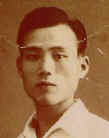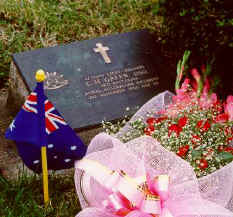An old woman is kneeling by a grave. She places a wreath on the headstone - white and blood red on the cold granite - and prays, head bowed.

Nothing unusual there. This could be a sight anywhere in Australia. She could be the widow, mother, sweetheart or sister of the person in the grave.
But she is not.
The place is a war cemetery; the woman is Korean; the grave is of a forever young Australian soldier whom she never met, and whose remains lie in this foreign soil.
The woman, Mrs Kim Chang-keun, visits the grave twice a year. Her care is even more remarkable because the seventy five year old woman travels alone over an 800 kilometre return trip by train to carry out this observance.
Mrs Kim’s story began in 1925, with her birth in a village in central Korea. She completed primary school and then, most unusually for a Korean country girl, moved to Seoul for secondary education. She became a school teacher.
By 1950 she was married - an arranged marriage to a handsome engineer - and had two small children.
But 1950 also saw the start of the Korean War. Mrs Kim’s husband, Kim In-Hyung, had joined the army a year before. Lieutenant Kim was immediately called up to fight the North Korean invasion.
The North quickly pushed the South all the way down to the south-eastern tip of the peninsula. Mrs Kim, stranded in Seoul with an invading army on the way, fled on foot as a refugee with her two small children and her mother, and with only the possessions they could carry back to her home village. It was a hard time for her, a time stained with blood and tears.
American troops of the United Nations force soon won back Seoul, and were pushing the North back to the Chinese border.
Mrs Kim had not heard from her husband. On 17 September 1950 she had a beautiful dream, of her husband in white walking beside her. They came to a pond - he walked to the left, she to the right. She called him, but he did not turn around or answer.

She determined to return to Seoul to find out news of him from the military authorities there. She went to an office, and though they tried to hide it from her, she saw her husband’s name on a list, killed in a fierce fight to stop the attacking North near Pusan, on 18 September.
Devastated, and with two infants as well as other members of her extended family now to care for, Mrs Kim showed her enormous strength of character and survived the war and the harsh period of reconstruction which followed. She turned to teaching, and became breadwinner for her family.
Then one day in 1961 she saw a report in a newspaper of an Australian woman, Mrs Healy, who had saved for years to visit her son’s grave in the United Nations War cemetery at Pusan. Sergeant Vincent Healy, aged 25, had been killed in a fight on an ice-covered hill in Korea.

Mrs Healy brought some soil from Australia to place on the grave, and took back some of the soil from the place where her son’s body lay. She stayed there for a week, grief-stricken, then left her son and returned to Australia. She knew she could never afford to see her son’s grave again. Mrs Kim recognised the pain and tragedy of a mother forever separated from her son, without even the comfort of visiting the place where he lay. She vowed then to take that Australian mother’s place, and twice a year since then has visited the grave, taken fresh flowers, and prayed for all the young men who died in that war.
Mrs Kim made great efforts to track down Mrs Healey, and corresponded with her for many years.

In 1998, after seeing a documentary film, Mrs Kim was touched by the story of the commander of the Australian forces, Lt Colonel Charlie Green, who also was killed during the war. Mrs Kim took over the emotional care of his grave, and has corresponded with his widow since then.
The Korean War is not well known in Australia. After the two World Wars and Vietnam, it is the largest war fought by Australians. The United Nations victory in Korea helped South Korea become a stable democracy, and an economic powerhouse which is one of Australia’s leading trading partners. Older people in Korea are conscious of the Australian connection, and feel great gratitude and affection for Australia still. Many well remember the distinctive slouch hat of the diggers. The young, however, know little about them. The cemetery at Pusan is therefore a small beacon of knowledge about Australia's sacrifice of 339 men for those students who visit the site.
On 25 April 1999 Mrs Kim's dedication and service to two Australians whom she never knew was rewarded by the Australian Government, when she was an honoured guest in Sydney and at the Australian War Memorial in Canberra, for ANZAC Day ceremonies.





